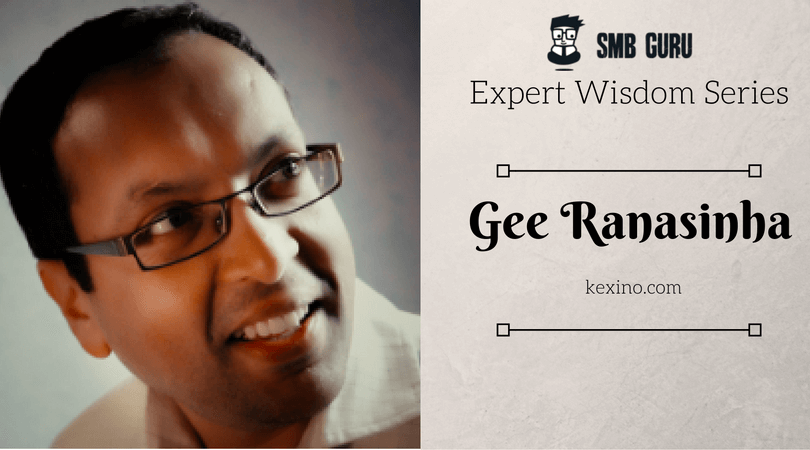Interview with Gee Ranasinha
Gee Ranasinha helps companies of all sizes raise the quality, efficiency and productivity of their marketing and communications. As a part of our SMB Expert Wisdom Project we contacted Gee Ranasinha of Kexino and asked him 5 questions.
1. How would you define ‘small business’ in 2016?
Today, every size of business needs to consider themselves a ‘small’ business. By that I don’t mean in terms of size, or number of staff, or turnover. I mean in terms of outlook, customer experience focus, and flexibility.
Conventional thinking was that the bigger you are as an organization, the more powerful you become. Sure, larger companies have the resources and infrastructure to reduce their transactional costs, and optimizing the value chain certainly reduces cost of sale. But it also assumes a large (and forever-growing) customer base to pay for this sort of scale, which I don’t believe is a sustainable strategy for the majority of businesses today. The problem with basing your business on building complex systems to optimize the production and transaction process, is that you’re assuming your product with always maintain relevance in the minds of your customers. Clearly, today that’s not the case – just ask Kodak, Nokia, or Sony.
The opportunity today lies at the periphery. Innovating and exploiting more fleeting, transient commercial opportunities. Small business thinking is perfectly placed to take advantage of such circumstances. It’s how (for example) Instagram could build 1m users just 2 months after its launch and sell to Facebook for $1bn, all while consisting of only 13 employees.
2. How do you think technology has re-shaped the SMEs (amazing and sad ways)?
Firstly, we should acknowledge that technology has always re-shaped SMEs – what we’ve seen over the past 15 years or so is, historically, nothing new. You can trace the implication of ‘technology’ on smaller business back to the Industrial Revolution, more than 250 years ago. Back then, big organizations invested in technology to vastly increase production. The result was SMEs either went out of business, or adapted their business model to address markets that were not well served by the big guys. It’s the same today, but with one big difference: the technology available to the big guys is also available to SMEs. The democratization of technology and process, the change in buyer behavior and expectation, compounded with a globalized market opportunity (or threat).
SMEs can no longer base their model simply on selling locally, or selling more cheaply. To continue to exist they need to adapt their value proposition in innovative and unique ways, that echo the trends in consumer buying behavior. In order to maintain relevance in the minds of their customers, SMEs must realign their technology and business models to more effectively engage consumers at every touchpoint. If they don’t, their competition most certainly will.
3. Please give 5 notions that would define small business owners in the future.
I think the main characteristic is one of embracing change. Historically, a business could invent something and sell it, perhaps without much change, for 50 years or more. Today, customer evolution is forcing businesses to adapt and innovate at an incredible pace. Business owners who are too entrenched or emotionally attached to particular products or processes will ultimately fail.
A second trait would be to understand where your competition comes from. This might seem obvious, but increasingly we’re seeing established companies – as well as entire industries – being upended from the most unexpected sources. The way we buy and listen to music, as well as our expectations of what a cellphone should be, was primarily disrupted by Apple – what was then primarily a computer company. Your hotel isn’t just in competition with Hilton, Marriott, or Best Western. It’s competing with comparison sites and (perhaps most of all, currently) Airbnb – a company that owns no property. Taxis vs Uber, retailers vs Amazon – the list goes on.
4. What’s the best strategy to overcome the Digital Divide?
The so-called Digital Divide is ultimately nothing more than customers using the most appropriate channel for them to engage with a brand. Whether the underlying reason is cultural, socio-economic, racial, religious, etc, is a much bigger question and something that SMEs cannot influence.
It used to be that businesses were in control of the transaction channels. Today, the customer is in control. The customer now decides how and where they will buy. It’s up to business to be where the customer expects them to be. For customers that don’t use digital communications, there are plenty of other media available for businesses to inform, educate, attract, and engage with their audience.
5. Who is your favourite blogger recently?
Don’t much like this question – unless I can say it’s me!

